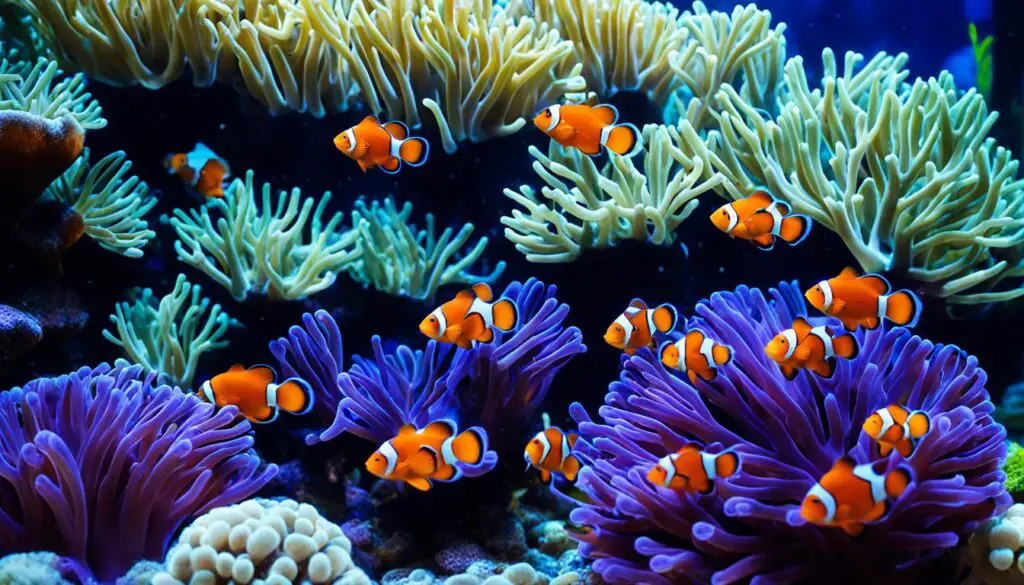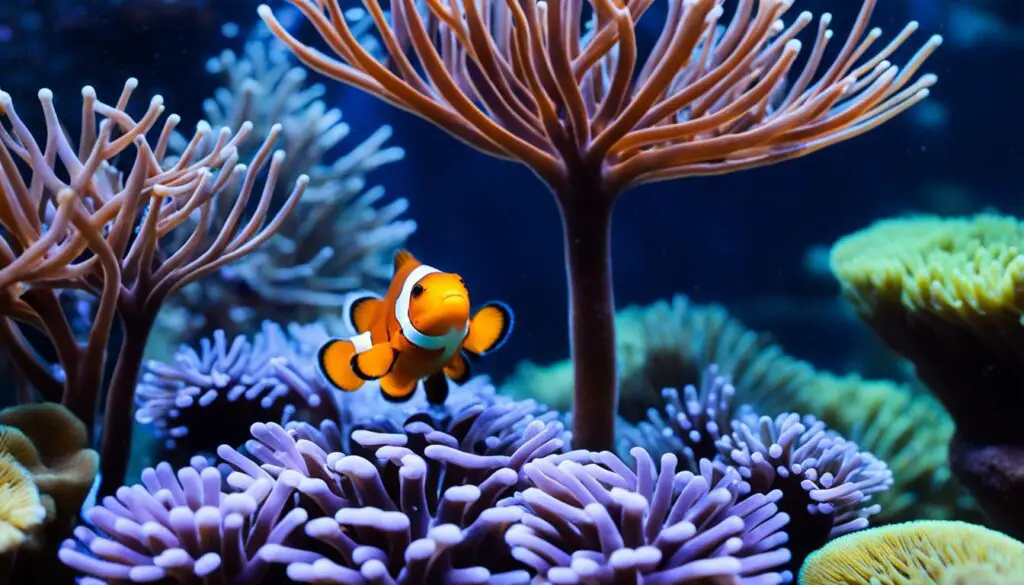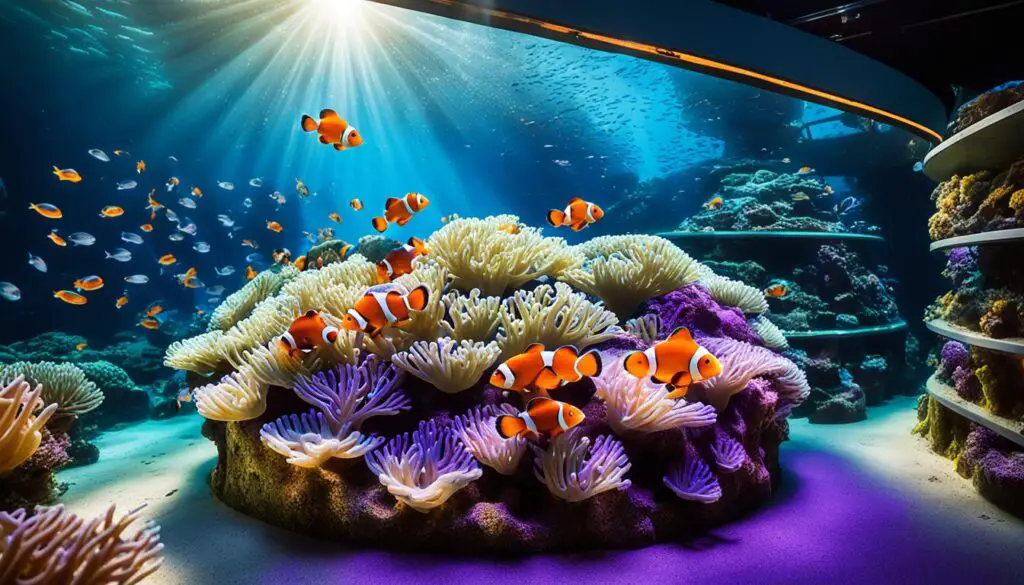Clownfish Tank Habitat Restoration: Rebuilding Ecosystems
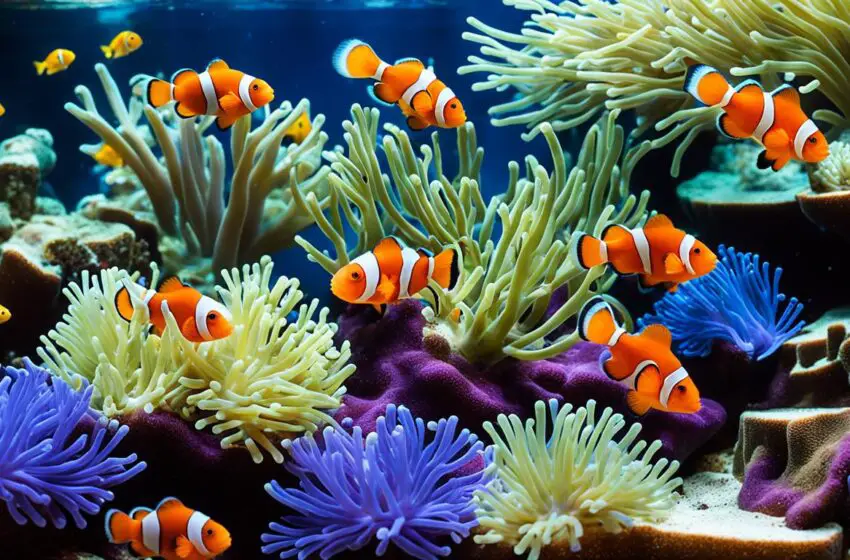
I care a lot about saving our oceans. The Yellowtail Clownfish is in trouble because of climate change. The warming planet and acidic oceans harm their homes, the coral reefs. These reefs are home to not just clownfish but many marine friends.
People are working hard to help the coral reefs survive for the clownfish. They fight against climate change and protect the sea. They also encourage fishing that won’t hurt the ocean.
Key Takeaways:
- Climate change poses a significant threat to the Yellowtail Clownfish and their coral reef habitats.
- Protecting and restoring coral reefs is critical for the survival and conservation of the clownfish and other marine species.
- Sustainable fishing practices play a vital role in preserving marine resources and ensuring the clownfish population’s sustainability.
- Coral reefs provide essential food, shelter, and breeding grounds for numerous marine species, highlighting their ecological importance.
- Collaborative conservation efforts are necessary to safeguard the Yellowtail Clownfish and maintain marine biodiversity.
The Impact of Climate Change on Coral Reefs
Rising temperatures and ocean acidification harm coral reefs greatly. These places, full of a wide variety of marine life, are under serious attack. They are suffering more now than ever before.
The situation is so bad that coral bleaching has become a major concern. It’s when corals lose their bright colors from stress. This makes them more likely to get sick and die. High ocean temperatures are usually the cause. This heat messes up the balance between corals and algae, affecting their health.
Also, ocean acidification is a big problem for coral reefs. More carbon dioxide in the atmosphere means the oceans are getting more acidic. This change makes it hard for corals to grow and heal from other damages.
The harm to coral reefs affects more than just the corals. It also harms the whole marine ecosystem that relies on them. Fish, crabs, and plants depend on coral reefs for shelter, breeding, and food. When coral reefs struggle, so does the whole ocean life chain. This imbalance threatens the sea’s health and stability.
“The alarming degradation of coral reefs due to climate change threatens not only the underwater beauty we cherish but also the very foundation of marine life. Urgent action is needed to mitigate the impacts of climate change and protect these invaluable ecosystems.”
To see how big the damage is, let’s look at some key facts:
| Coral Reef Statistic | Data |
|---|---|
| Total Global Coral Reef Area | Less than 0.1% of the world’s oceanic area |
| Extent of Coral Bleaching Events | Affected reefs in more than 90 countries since the 1980s |
| Estimated Coral Reef Loss | Around 50% in the last 30 years |
| Predicted Coral Reef Loss by 2050 | Up to 90% if current rates of global warming continue unabated |

These facts show why we must act fast against climate change. We need to do more to protect coral reefs. It’s for us and the coming generations.
The Natural Habitat of the Yellowtail Clownfish
Exploring the world of the Yellowtail Clownfish shows its close ties to coral reefs. It lives in the Indo-Pacific’s coral reefs, especially in the Coral Triangle. The Coral Triangle is famous for its incredible underwater scenes. It’s a place where many different species, like this clownfish, live together.
The Yellowtail Clownfish and anemones share a unique bond. The clownfish uses the anemones for shelter, staying safe from danger. In return, the anemones get food bits from the clownfish’s meals. This shows how marine life relies on each other for survival.
This fish depends a lot on the coral reefs. They are its home and source of food. Coral reefs are full of life, offering many meals for the Yellowtail Clownfish like algae and small creatures.
Looking at the Coral Triangle’s amazing pictures, we see why the Yellowtail Clownfish fits so well there. Its bright colors and features help it blend in with the coral reefs. From the beautiful sea views to the anemones, the Coral Triangle is truly where this fish belongs.
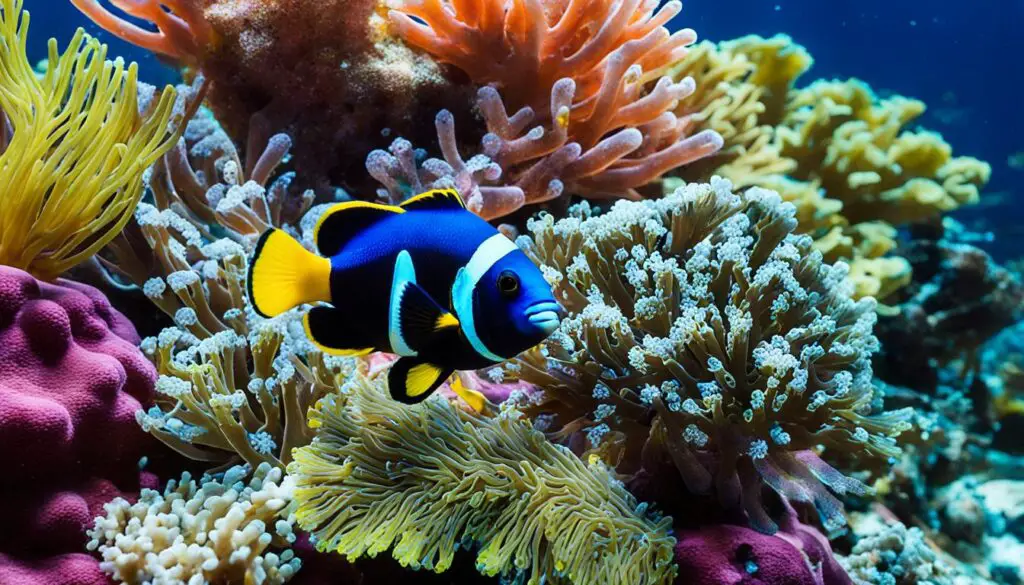
Did you know?
The Coral Triangle region is about 5.7 million square kilometers big. It’s home to over 75% of known coral species. This area is a marine wonder, needing our care to protect it.
Conservation Strategies for the Yellowtail Clownfish
Conservation is key to keeping the Yellowtail Clownfish safe and protecting marine life’s diversity. Protecting and healing coral reefs is at the heart of this effort. They offer homes, food, and places to breed for the clownfish.
To help the Yellowtail Clownfish, it’s crucial to fish sustainably. This means using fishing gear that picks specific fish and setting limits on how many can be caught. This way, we avoid catching too many and keep the ocean healthy.
Climate change is also a big threat. It affects the ocean and the clownfish’s homes. To fight this, we must reduce things that make the climate change. Using more clean energy is a big part of this. It helps the clownfish and the whole ocean stay healthy.
We need a mix of plans to save the Yellowtail Clownfish. These include keeping coral reefs safe, fishing carefully, and fighting climate change. By doing these things together, we help not only the clownfish but also the oceans themselves.
FAQ
What are the main challenges faced by the Yellowtail Clownfish from climate change?
The Yellowtail Clownfish faces challenges from climate change. This includes global warming and ocean acidification. These issues lead to coral reef degradation, which hurts the clownfish’s home.
Why is coral reef restoration important for the survival of the Yellowtail Clownfish?
It’s important to protect and restore coral reefs for the clownfish. Reefs are crucial as they offer food, shelter, and breeding spots. Many marine animals, including the clownfish, rely on these reefs.
How are sustainable fishing practices related to the conservation of the clownfish population?
Sustainable fishing plays a big role in protecting clownfish and their homes. It includes using methods that don’t harm the ocean. This stops overfishing and keeps the marine environment healthy for all.
How does climate change affect coral reefs?
Climate change causes coral bleaching and ocean acidification, which are bad for reefs. Bleaching makes corals lose their color and can lead to death. Ocean acidification stops coral from growing well, making it hard for reefs to survive.
Where is the natural habitat of the Yellowtail Clownfish?
The Yellowtail Clownfish lives in the Indo-Pacific’s coral reefs, especially the Coral Triangle. This area is rich in coral and anemones, making it a perfect home for the fish.
How does the Yellowtail Clownfish interact with anemones in its natural habitat?
The clownfish has a special bond with anemones. It lives among the anemone’s tentacles for safety, food, and nutrients. This relationship helps both the fish and the anemones thrive.
How do conservation strategies aim to protect the Yellowtail Clownfish?
Conservation focuses on saving coral reefs, crucial for the clownfish’s life. It includes sustainable fishing and fighting climate change. These efforts are key to the fish’s survival.
Why is comprehensive conservation necessary for the preservation of the Yellowtail Clownfish?
Full-on efforts are crucial to save the Yellowtail Clownfish and its world. This fish needs healthy reefs to live. By protecting the reefs and using eco-friendly methods, we secure its future.

